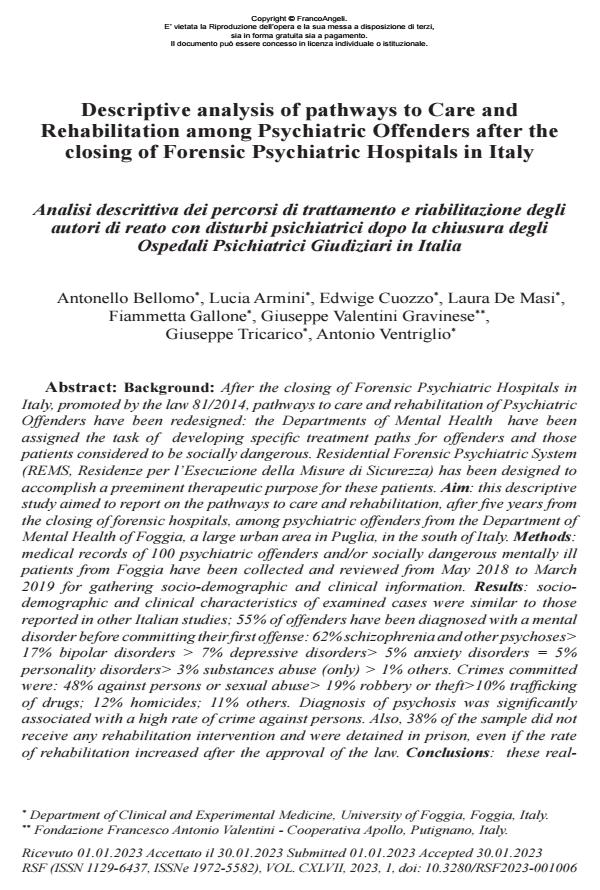Descriptive analysis of pathways to Care and Rehabilitation among Psychiatric Offenders after the closing of Forensic Psychiatric Hospitals in Italy
Titolo Rivista RIVISTA SPERIMENTALE DI FRENIATRIA
Autori/Curatori Antonello Bellomo, Lucia Armini, Edwige Cuozzo, Laura De Masi, Fiammetta Gallone, Giuseppe Valentini Gravinese, Giuseppe Tricarico, Antonio Ventriglio
Anno di pubblicazione 2023 Fascicolo 2023/1
Lingua Inglese Numero pagine 16 P. 87-102 Dimensione file 198 KB
DOI 10.3280/RSF2023-001006
Il DOI è il codice a barre della proprietà intellettuale: per saperne di più
clicca qui
Qui sotto puoi vedere in anteprima la prima pagina di questo articolo.
Se questo articolo ti interessa, lo puoi acquistare (e scaricare in formato pdf) seguendo le facili indicazioni per acquistare il download credit. Acquista Download Credits per scaricare questo Articolo in formato PDF

FrancoAngeli è membro della Publishers International Linking Association, Inc (PILA)associazione indipendente e non profit per facilitare (attraverso i servizi tecnologici implementati da CrossRef.org) l’accesso degli studiosi ai contenuti digitali nelle pubblicazioni professionali e scientifiche
After the closing of Forensic Psychiatric Hospitals in Italy, promoted by the law 81/2014, pathways to care and rehabilitation of Psychiatric Offenders have been redesigned: the Departments of Mental Health have been assigned the task of developing specific treatment paths for offenders and those patients considered to be socially dangerous. Residential Forensic Psychiatric System (REMS, Residenze per l’Esecuzione della Misure di Sicurezza) has been designed to accomplish a preeminent therapeutic purpose for these patients. Aim: this descriptive study aimed to report on the pathways to care and rehabilitation, after five years from the closing of forensic hospitals, among psychiatric offenders from the Department of Mental Health of Foggia, a large urban area in Puglia, in the south of Italy. Methods: medical records of 100 psychiatric offenders and/or socially dangerous mentally ill patients from Foggia have been collected and reviewed from May 2018 to March 2019 for gathering socio-demographic and clinical information. Results: socio- demographic and clinical characteristics of examined cases were similar to those reported in other Italian studies; 55% of offenders have been diagnosed with a mental disorder before committing their first offense: 62% schizophrenia and other psychoses> 17% bipolar disorders > 7% depressive disorders> 5% anxiety disorders = 5% personality disorders> 3% substances abuse (only) > 1% others. Crimes committed were: 48% against persons or sexual abuse> 19% robbery or theft>10% trafficking of drugs; 12% homicides; 11% others. Diagnosis of psychosis was significantly associated with a high rate of crime against persons. Also, 38% of the sample did not receive any rehabilitation intervention and were detained in prison, even if the rate of rehabilitation increased after the approval of the law. Conclusions: these realworld findings reported on the increase of specific rehabilitation interventions for psychiatric offenders after five years from the closing of forensic hospitals. Emerging characteristics of this study may suggest new tailored interventions to be discussed and adopted in the clinical management of this challenging group of severely mentally ill patients.
dopo la chiusura degli Ospedali Psichiatrici Giudiziari (OPG) in Italia, disposta dalla legge 81/2014 nuovi percorsi di cura e riabilitazione sono stati introdotti per i pazienti psichiatrici autori di reato: i Dipartimenti di Salute Mentale hanno il compito di individuare idonei percorsi di cura per coloro che hanno commesso un reato o ricevuto una valutazione di pericolosità sociale. Le Residenze per l’Esecuzione della Misure di Sicurezza (REMS) nascono quali strutture dedicate per la riabilitazione, cura ed esecuzione della misura di sicurezza a favore di tali utenti. Obiettivo: questo studio descrittivo riporta i dati circa i percorsi di cura e riabilitazione individuati per i pazienti psichiatrici autori di reato afferenti al Dipartimento di Salute Mentale di Foggia a cinque anni dalla chiusura degli OPG. Metodi: le cartelle e documentazione clinica di 100 pazienti autori di reato e/o socialmente pericolosi, afferenti al Dipartimento di Salute Mentale di Foggia, sono state raccolte ed esaminate da Maggio 2018 a Marzo 2019. Sono state estrapolate informazioni socio-demografiche e cliniche. Risultati: le caratteristiche socio-demografiche e cliniche dei pazienti esaminati si sono rivelate simili a quelle riportate in altri campioni italiani; il 55% degli autori di reato aveva ricevuto una diagnosi psichiatrica già prima del reato compiuto: il 62% schizofrenia e altre psicosi> 17 disturbi bipolari> 7% disturbi depressivi> 5% disturbi d’ansia = disturbi di personalità> 3% disturbo da uso di sostanze> 1% altri. I reati commessi sono stati: 48% reati contro la persona o sessuali> 19% rapina e furto> 10% traffico di stupefacenti; 12% il tasso di omicidi e 11% altri reati di vario genere. La diagnosi di psicosi è stata associata ad un più elevato tasso di reati contro la persona. Inoltre, il 38% del campione non è stato beneficiario di interventi riabilitativi ed era in stato di detenzione sebbene il tasso di invii alla riabilitazione abbia mostrato un incremento dopo l’approvazione della legge. Conclusioni: i risultati di questo studio real-world confermano un incremento degli interventi riabilitativi destinati agli autori di reato a cinque anni dalla approvazione della legge 81/2014 e le caratteristiche del campione possono suggerire nuovi indirizzi per interventi di precisione su questa tipologia di utenti della salute mentale.
Parole chiave:REMS, Ospedali Psichiatrici Giudiziari, Pazienti psichiatrici autori di reato, Misure di sicurezza, riabilitazione
Antonello Bellomo, Lucia Armini, Edwige Cuozzo, Laura De Masi, Fiammetta Gallone, Giuseppe Valentini Gravinese, Giuseppe Tricarico, Antonio Ventriglio, Descriptive analysis of pathways to Care and Rehabilitation among Psychiatric Offenders after the closing of Forensic Psychiatric Hospitals in Italy in "RIVISTA SPERIMENTALE DI FRENIATRIA" 1/2023, pp 87-102, DOI: 10.3280/RSF2023-001006